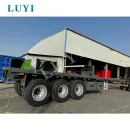What Is a Flatbed Semi Trailer?
A flatbed semi trailer is a type of trailer without sides or a roof, designed to transport large or heavy cargo that requires easy loading and unloading. Commonly used in industries such as construction, agriculture, and logistics, these trailers provide a versatile solution for transporting goods ranging from machinery to building materials. Understanding the specifications and design of flatbed trailers can help businesses select the right model for their needs.
What Are the Key Features of Flatbed Semi Trailers?
Flatbed semi trailers are characterized by several key features, including:
Load Capacity: The load capacity varies based on the trailer's construction, with most models capable of carrying between 48,000 to 60,000 pounds.
Deck Length and Width: Standard deck lengths range from 40 to 53 feet, with widths typically around 8.5 feet.
Materials: Most flatbed trailers are made from steel or aluminum, providing a balance between strength and weight.
Adjustable Features: Many models come with adjustable outriggers and tie-down points for securing loads effectively.
Selecting the right flatbed semi trailer involves considering several factors:
Type of Cargo: Evaluate the size, weight, and nature of the cargo you'll be transporting. Some trailers are better suited for heavier or oversized loads.
Frequency of Use: Determine how often you will use the trailer. A higher-quality trailer may be necessary for frequent use, while occasional transport might allow for more economical options.
Compatibility with Your Truck: Ensure that the trailer’s specifications match your truck’s towing capacity and compatibility features.
Budget: Consider both the initial purchase price and long-term maintenance costs when selecting a trailer.

What Maintenance Is Required for Flatbed Semi Trailers?
Regular maintenance is crucial for the safe operation of flatbed semi trailers. Key maintenance tasks include:
Inspections: Conduct regular inspections of the frame, tires, and brakes to identify any wear or damage.
Tire Care: Regularly check tire pressure and tread depth to prevent blowouts and ensure safe towing.
Lubrication: Keep moving parts well-lubricated to minimize friction and wear.
Load Security: Ensure that all tie-downs and securing mechanisms are in good condition and used properly to prevent cargo shifting during transport.
What Are the Advantages of Using Flatbed Semi Trailers?
Flatbed semi trailers offer numerous advantages:
Versatility: They can transport a wide variety of cargo, from machinery to building materials.
Easy Loading and Unloading: The open design allows for quick access, making it easy to load and unload with cranes or forklifts.
Cost-Effective: They often have a lower initial cost compared to enclosed trailers, and their simplicity can lead to lower maintenance expenses.
What Should I Consider When Loading a Flatbed Semi Trailer?
Loading a flatbed semi trailer requires careful planning and execution:
Weight Distribution: Ensure the load is evenly distributed across the trailer to maintain stability and avoid swaying during transport.
Height Considerations: Be mindful of the overall height of the loaded trailer, as this may affect travel through underpasses and bridges.
Securing the Load: Use appropriate tie-down methods and equipment to secure the cargo and prevent it from shifting or falling off during transport.
Conclusion
Understanding the essentials of extendable flatbed semi trailers, from features and maintenance to loading considerations, is crucial for making informed decisions that enhance operational efficiency. By addressing these common questions, businesses can better navigate the challenges associated with selecting and using flatbed semi trailers in their operations.





Comments
All Comments ( 0 )